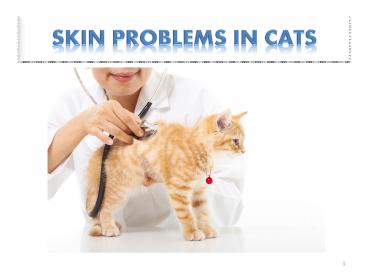Common Skin Problems in Cats PowerPoint PPT Presentation
Title: Common Skin Problems in Cats
1
Skin Problems in Cats
2
- If your cat sitting on that porch is
constantly scratching, licking or rubbing against
the hard furniture, then the culprit for this
condition of your feline friend is the skin
problem. - Being cat skin quite sensitive, they are
highly susceptible to allergies, skin infections,
parasites and many other conditions that pave the
way to skin conditions. - To help you figure out the most common skin
problems in cats and how well you can treat them
as well as how to protect your kitty from these
health conditions, here we go.
3
Bacterial Infections
4
- Normally, a bacterial infection is the result
of other skin problems. For e.g., a rash when
left untreated can gradually lead to bacterial
infections, which when becomes severe is quite
difficult to tackle. - Antibiotics usually work best and are given
for treating these infections. - However, it is quite important to find that
underlying skin problem in order to control the
recurrence or further deterioration.
5
Feline Acne
6
- ACNE it is not only your date night
disaster, but cats do also suffer from this. - They primarily get these pimples on and around
their chin. - And, the most common causes for pimples to
appear on felines are stress, a reaction to a
medication, poor grooming and underlying skin
condition. - It can even be the plastic bowl that you put
out for her food or water.
7
Yeast Infections
8
- Cat ear is the most common spot that suffers
from yeast infection. - Normally, this is caused by a fungus and is
also more likely in cats that have the medical
history of other skin problems. - Yellow discharge, redness of the ear flap and
persistent ear scratching are some of the common
signs of yeast infection. - It can be treated well with antifungal
medication such as Epi-otic Ear Cleaner for
cats. - However, it is always a wise choice to refer
to your veterinarian before giving any oral
medicine.
9
Ringworm
10
- Ringworm affects cats especially under the age
of 1. - It is yet another type of fungus that may
cause circular lesions on a cats ears, head, and
forelimbs as well as any other part of the body. - Being contagious and zoonotic by nature,
ringworm can spread to other pets in the home as
well as humans. - Treatment depends on severity but there can be
specialized shampoos, ointments or oral
medications available for this skin problem.
11
Allergic Dermatitis
12
- Allergies can be caused due to various
reasons. - Cats may succumb to reactions to grooming
products, food and environmental irritants like
pollen or flea bites. - Some of the common symptoms of food allergies
are scratching the head or neck whereas the
symptoms of other allergies include scratching
the back of the ears or chewing the back of the
tail. - Allergies can also cause hair loss or skin
lesion anywhere on the body, including the belly.
- There are a variety of treatments and
supplements that treat this itchy skin problem in
cats. - However, avoiding exposure to allergens can
be the best idea.
13
Hair Loss
14
- With cat living with you, it is natural for
you to deal with hair everywhere in the house. - But, the real shock comes when you find that
your cat is losing hair unusually with baldness
or small batches without hair everywhere or at
specific places.
15
Fleas
16
- If you think that fleas would not affect your
cats skin condition, then be ready to break your
own myth. - These tiny critters instigate persistent
scratching, crusty lesions, and red rashes. - To remove that, you need to provide flea
treatments for your cat. - Furthermore, in order to control future flea
infestations, it is crucial that you need to keep
her on monthly flea preventives as well as treat
her bedding, furniture, and rugs. - In case, you have other pets in your house, it
is crucial that you treat them also to completely
protect against flea infestations.
17
Ear Mites
18
- Apart from fleas, the other parasite that
usually attacks cats is ear mites. - These tiny parasites mostly depend on wax and
oil inside a cats ear. - Feeding on these things, they cause
inflammation, which can gradually lead to severe
skin as well as ear infections. - Due to the presence of ear mites, cats can
continuously scratch the ears, shake head and at
times, this can even result in a dark discharge
from the ears and bad odor. - If you suspect ear mites, it is crucial to
treat your cat for the same because ear mites not
only deteriorate the skin condition of your furry
pal but are also contagious and can spread to
other animals.
19
- Skin problems in cats can be effectively
handled and treated if you take care of your
kitty. - Proper grooming, nourishment, healthy diet,
monthly flea, and ear mite treatments along
with skin care supplements can profusely aid in
keeping your cats skin healthy and glowing.

